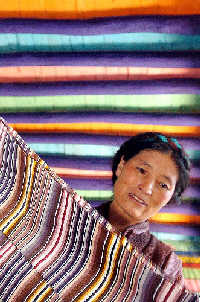|
Pulu Fabric
( 2005-10-27 )
 Pulu is Tibetans' traditional woolen fabric and the main material for making robes, boots, hats, and other items for Tibetans in farming areas, and in cities and towns. The fabric has a history of more than 2,000 years. Pulu is as important and popular among Tibetans as cotton clothes are to inland Chinese. Pulu is Tibetans' traditional woolen fabric and the main material for making robes, boots, hats, and other items for Tibetans in farming areas, and in cities and towns. The fabric has a history of more than 2,000 years. Pulu is as important and popular among Tibetans as cotton clothes are to inland Chinese.
Pulu is fine and thick, soft and smooth. It is made of Tibetan felt and usually white. Wool is the raw ingredient in the process of making the material.
First, it is fluffed and combed before it is twisted into a thread around a spindle using fingers. It is then weaved with a wood shuttle loom into pulu.
The fabric is generally about 24 centimeters wide, and can be dyed black to be made into clothes, shoes and hats. It is typically dyed red, blue or green when it is used as adornment. In addition to monochromatic cloth, pulu can also be dyed with cross-shaped designs.
Pulu is found in many types. It is thick and durable, warm, windproof, and rainproof. Robes made of pulu are water-repellent.
There are clear and definite records showing that pulu fabric was very popular in theTang Dynasty(618-907). In theYuan Dynasty(1271-1368), pulu was carried to the imperial palaces of the Central Plains as a tribute.
Pulu production is quite popular in agricultural areas and areas that are semi-agricultural and practice some animal husbandry. Chanang, Nanggarze, Gyangze and Mangkan are best known for their production of pulu, and products made with it are transported and sold in other places of China and even abroad.
|

